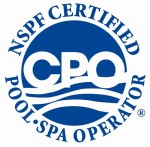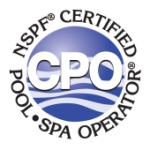The following test factors may occasionally be a factor in your water management program. Learning about them will make it easier to understand why a pool professional may be asking you to take action to protect your pool or spa from an undesirable water condition. Except for temperature, most of these tests are done solely by pool pros either in a retail store or on-site. This will also help the pool or spa owner identify what symptoms may lead to future problems.
Cyanuric Acid
Cyanuric acid is used to protect chlorine from UV degradation by sunlight. In sun-belt regions, higher levels of cyanuric acid are common due to the user’s eagerness to protect their chlorine and because cyanuric acid does not dissipate by itself. The only way to reduce cyanuric acid levels is by adding fresh water. Since health agencies feel high levels of cyanuric acid may inhibit the reactivity of free chlorine, most pool owners are directed to stay below 150 ppm. Cyanuric acid levels should be tested monthly, especially if free chlorine is rapidly lost or the pool has been on dichlor or trichlor (chlorines that contain cyanuric acid) for a year or more.
The ideal range for cyanuric acid I pools is 30-100 ppm, this could vary by region.
Temperature
While water temperature is an important comfort factor for bathers, it can also play a small role in accelerating corrosion or scale formations. In warmer water, calcium carbonate is more likely to precipitate out of solution and contribute to a scale forming condition. At colder temperatures, water is more prone to corrosion if it does not have adequate calcium carbonate. When visiting a pool store to get a comprehensive water analysis, be sure to read your thermometer when taking the pool sample since the temperature of the water is factored into what is calculated as the saturation index. The saturation index is a numerical assessment of the potential for the water to cause corrosion or deposit scale.
The ideal temperature range for pools is 75-85° and spas are 95-104°.
Total Dissolved Solids (TDS)
A total dissolved solids reading indicates the amount of dissolved substances or minerals in the water. These come from the original water supply and from treatment chemicals. As water evaporates, the dissolved solids remain and over time continue to increase. A high dissolved solids level can lead to corrosion. If the water exceeds 2,000 ppm, investigate ways to replace a portion of the water supply. Most pool stores have a dissolved solids meter designed to measure TDS in seconds.
The ideal TDS range for pools and spas is less than 2,000 ppm (for salt water pools consult a pool professional).
Metals (copper, iron, manganese)
The levels of metals in water are monitored to avoid colored water and stains on pool or spa surfaces. Since stains from dissolved metals are troublesome to remove, most pool professionals like to test for at least copper and iron in the spring or several times a year as a precaution. Copper will tend to stain surfaces (including hair) blue-green and can cause water to become a tint of aquamarine after a high chlorine dosage. Iron can leave stains of a brown or rusty color and can turn water green or brown following a chlorine dose.
Manganese is much rarer than copper or iron, but can leave behind blackish specks on the walls and components. Pool professionals normally recommend metal sequestering agents to remove unwanted metals before problems start. Note: some sanitation systems use copper treatment compounds to inhibit algae growth. When those forms of copper are properly maintained or chelated (bound in a form that cannot fall out and cause problems), copper can provide a useful service. Most pool stores have ways to test for metals, but remember that the analysis may take several minutes.
The ideal level of metals for pools and spas is less than 0.3 ppm for each.
Nitrate and Phosphate
The combination of nitrate and phosphate is the building block for algae. Fortunately, if one is eliminated the other cannot produce algae on its own. Large amounts of nitrates can cause other problems, such as increases in chlorine demand. For example, an enormous amount of chlorine is added in the morning, and is gone by the afternoon. This occurrence is more common in seasonal pools that have just been reopened because nitrates can enter the water from leaves or debris that were recently removed. Other sources of nitrate intrusion come from well water supplies and localized spraying of garden or crop fertilizers.
Since nitrates can only be removed by draining the water, some manufacturers have focused on removing the other algae nutrient, phosphate. A variety of phosphate removal systems have been introduced to eliminate the potential for algae. Phosphates can enter the water from municipal water supplies (where they are used for corrosion and metal control) and from some forms of metal sequestering agents (as the organic phosphate called phosphonate breaks down to ortho-phosphate). By maintaining a constant level of 1.0 ppm or higher of free chlorine in the pool or spa, algae should normally not be a problem. If an alga develops, promptly see a pool professional.
The ideal range for pools and spas is less than 10 ppm nitrate and less than 100 ppb phosphate.




